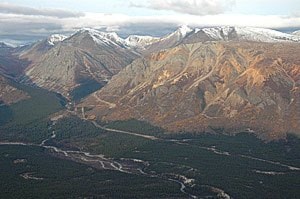With no fanfare — or even a public announcement — the Yukon government has appointed another project champion to a mining prospect in the territory.
Tagish Lake Gold Corp. announced last week that Randy Clarkson, an engineer from Whitehorse, was assigned to its Skukum Creek gold-silver project in the Wheaton River valley “to assist the company through the regulatory process in a timely manner.”
Clarkson’s job will be to “facilitate all activities related to government for environmental assessment and permitting,” Tagish Lake president Robert Rodger said in a release.
“This should aid in the process of obtaining the necessary permits required to achieve production at our project,” said Rodger.
“This appointment is a clear sign of the Yukon government’s commitment to promote mining in the Yukon territory.”
Clarkson is a private consultant with 20 years of experience working in the Yukon on mining-related affairs.
He was the mining engineer at the Skukum property in 1984 and 1985.
“I’ve lived here since 1980, so pretty well everybody in mining knows me here,” Clarkson said Tuesday.
“The government of the Yukon has appointed project co-ordinators to most of the developing mine projects.”
The Yukon Party government instituted the role of “project co-ordinators” in the wake of devolution, said Bob Holmes, director of mineral management for Energy, Mines and Resources.
“With devolution, responsibilities for mining are split into several different departments,” Holmes said Tuesday.
“It was apparent that we needed a number of mechanisms to implement decision-making in the Yukon government.”
The Yukon Party government implemented an “integrated resource-management policy” to cope with the changes.
A “deputy ministers’ oversight committee” was put into place.
The notion of project co-ordinators flowed from that committee, said Holmes.
“It’s intended to facilitate good communication between the company and government, across the different departments.”
The co-ordinators don’t prevent government regulators from talking to the company, he said.
“The co-ordinator is there to make sure we’re all working together effectively in an integrated way.”
However, project co-ordinators — or “champions” — came under fire in 2005, when Yukon Development Corporation chair Willard Phelps, a former Yukon Party cabinet minister, was acting in an advocacy role for the Carmacks Copper project.
Phelps hasn’t been on that file for more than a year, Resources minister Archie Lang said in May.
Currently there are three independent project co-ordinators working on prospects in the territory, said Holmes.
The Wolverine property, owned by Yukon Zinc Corp., and the Division Mountain coal deposit, owned by Cash Minerals Inc., both have government project co-ordinators working for them.
Clarkson, who doubles as project co-ordinator for the Carmacks Copper project, was chosen for Skukum Creek because of his familiarity with the project and technical expertise, said Holmes.
For more advanced projects that are preparing to seek regulatory approval, such as Skukum Creek, Resources will sole-source a year-long contract to a known mining authority, such as Clarkson.
For less advanced projects, such as Division Mountain, the role of the project co-ordinator falls to Resources employees.
In the case of Division Mountain, mineral development manager Kevin Brewer co-ordinates the project for government, said Holmes.
The most advanced major mining project in the Yukon at the moment is the Minto property owned by Sherwood Copper Corp.
For more than a year, Bill Dunn, a senior minerals development adviser with the government, worked as project co-ordinator for Sherwood Copper.
Sherwood Copper cleared most of its regulatory hurdles with grandfathered permits that were in place before the Yukon Environmental and Socioeconomic Assessment Act took full effect last fall.
In 2006, Dunn quit the government to work for Sherwood Copper directly, once the company no longer needed a project co-ordinator.
The co-ordinators are supposed to have clear entry and exit points, said Holmes.
They are assigned once a company is preparing to apply to the new assessment process.
They are supposed to guide the company through the process.
Once a company receives its licences, the co-ordinator should no longer be necessary.
“The fact that we assign a project co-ordinator sends a signal that government is taking this project seriously,” said Holmes.
But they shouldn’t be necessary, said Porter Creek South MLA Pat Duncan.
“The regulatory and permitting process is so complex that the government is saying, ‘We’ll provide someone to help you, the mining company, through it,’” said Duncan, the former Liberal premier.
“Once we got devolution, it was a golden opportunity, and it also represented, for the government, the challenge to do the hard work of regulatory process and policy development.
“Minister Lang, in the years they have had devolution, three years now, hasn’t done it.
“What he has done, instead, is treated the issue by funding a body to help companies, rather than dealing with the issue and doing the hard work of government.”
What’s more, the tactic of assigning project champions to industrial developments betrays an imbalance of the government’s priorities, said Yukon Conservation Society spokeswoman Shirley Roburn.
“The real concern with YESAA, or with any regulation, is the fact that all this money is going into project champions and not enough is going into water inspectors or the kinds of things that are the duty and responsibility of government,” said Roburn.
